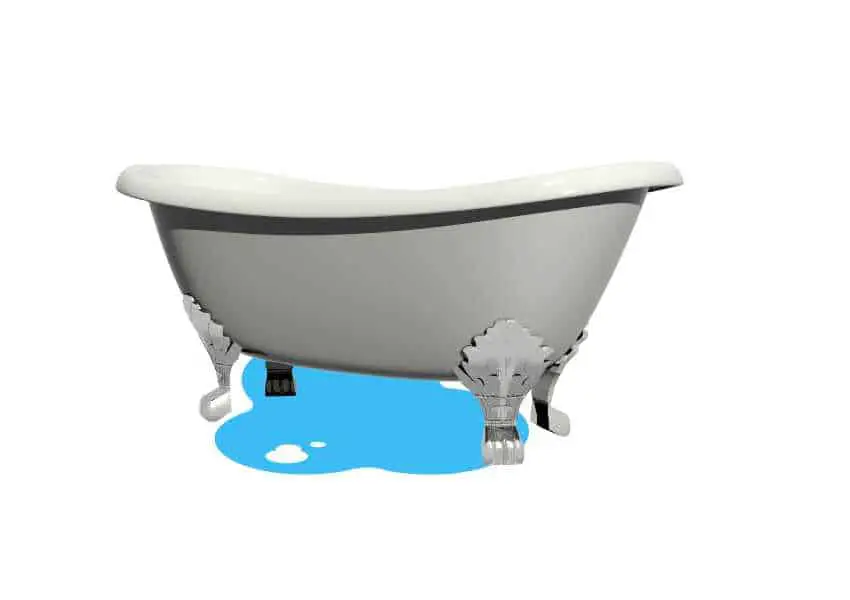Have you ever considered whether your bathtub could leak? Well, let me tell you, it certainly can. And let me tell you, it’s not a pretty sight.
But don’t worry, I’m here to give you all the information you need to know about the causes, signs, and solutions for a leaky bathtub.

Causes of Bathtub Leaks
First things first, let’s talk about the causes. A bathtub can develop a leak for a variety of reasons, such as a cracked or worn tub, a damaged drain, or faulty plumbing.
Now, I know some of you may be thinking, “But my bathtub is brand new, it can’t be cracked!” But let me tell you, even the newest of bathtubs can develop cracks over time due to heavy use or even the natural settling of your home.
And as for that drain, well, let’s just say that hair and soap scum can do a number on it if not properly maintained. And last but not least, faulty plumbing I mean, let’s face it, we’ve all had a leaky faucet at some point in our lives, so it’s not surprising that the same can happen with your bathtub.
Signs of a Leaky Bathtub
Now that we know the causes, let’s talk about the signs of a leaky bathtub. Water damage on the walls or ceiling, a musty smell, or a constantly damp floor are all clear indicators that something is not right with your tub.
But if those signs are not present, don’t worry, there are still ways to detect a leak. One way is to simply check for water stains or feel for moisture under the tub.
I know, it’s not the most glamorous task, but trust me, it’s worth it to catch a leak early on.
How to Fix a Leaky Bathtub
So, you’ve detected a leak, now what? Well, it’s time to fix it. And there are a few different methods for repairing a leaky bathtub. Patching a crack, replacing a damaged drain, or fixing faulty plumbing are all options.
And don’t worry, I’m not going to leave you hanging, I’ll give you step-by-step instructions for each method. But before you start any repairs, I highly recommend turning off the water supply to your bathroom to prevent any further damage.
Let’s start with patching a crack. First, you’ll need to clean the area around the crack with a mixture of water and mild detergent.
Next, apply a small amount of epoxy or acrylic filler to the crack and smooth it out with a putty knife. Allow it to dry for the recommended amount of time, and voila, your crack is patched.
Next, let’s talk about replacing a damaged drain. This one is a bit more complicated, but don’t worry, I’ll walk you through it.
First, remove the drain cover and use a pair of pliers to remove the strainer. Next, use a pipe wrench to loosen and remove the drain assembly. Take the old drain assembly to your local hardware store to ensure you get the right replacement.
Once you have the new drain assembly, reverse the steps you took to remove the old one, and voila, you have a brand new drain.
And last but not least, fixing faulty plumbing; This one is best left to the professionals, but in case you’re feeling adventurous, here’s a quick overview. First, locate the shut off valves for the bathroom and turn off the water supply.
Next, use a pipe wrench to loosen and remove the old valve. Take the old valve with you to the hardware store to ensure you get the right replacement. Once you have the new valve, reverse the steps you took to remove the old one, and then turn the water supply back on. Test the valve to make sure it’s functioning properly, and if it’s not, you might have to call a plumber.
Now, I know some of you might be thinking, “But wait, I’m not handy at all, I can’t do any of this!” and that’s totally okay. These repairs can be difficult and time-consuming, and if you’re not comfortable doing them, it’s best to call a professional.
They’ll be able to fix the leak quickly and efficiently, giving you peace of mind that the job was done right.
Conclusion
In conclusion, a bathtub can certainly leak, and it’s important to know the causes, signs, and solutions for a leaky bathtub. Remember to check for water damage, musty smells, and damp floors, and if you do detect a leak, don’t hesitate to call a professional.
And lastly, regular maintenance can go a long way in preventing leaks in the future, so make sure to keep your bathtub clean and in good condition.
And there you have it, folks—all the information you need to know about a leaky bathtub. I hope this article helped and that you’re able to tackle any leaks that come your way. If you have any further questions or need professional help, don’t hesitate to reach out to a plumber or contractor in your area.
FAQ
How can I prevent my bathtub from leaking?
Regular maintenance is the key to preventing leaks in your bathtub. Here are a few tips to help keep your tub in good condition:
- Clean your bathtub regularly with a mild detergent to prevent the buildup of hair and soap scum in the drain.
- Check your bathtub often for cracks or other signs of wear, and fix any problems as soon as you find them.
- Make sure to have any faulty plumbing, such as leaky faucets, fixed as soon as possible.
- Check the caulking around your bathtub on a regular basis to make sure it hasn’t cracked or peeled.
How do I know if my bathtub is leaking?
There are a few signs that indicate a bathtub may be leaking, such as water damage on the walls or ceiling, a musty smell, or a constantly damp floor. Additionally, you can check for water stains or feel for moisture under the tub.
Can a leaky bathtub cause mold or mildew?
Yes, a leaky bathtub can cause mold or mildew to form. Water that’s left standing in or around your bathtub can create the perfect environment for mold and mildew to grow. If you notice a musty smell or visible mold or mildew in your bathroom, it’s important to address the leak as soon as possible.
How long does it take to fix a leaky bathtub?
The time it takes to fix a leaky bathtub will depend on the cause of the leak. A simple crack or worn tub can be fixed in a few hours. Replacing a damaged drain or fixing faulty plumbing can take a bit longer, but it’s best to seek professional help to fix this kind of leak.
Can I use silicone caulk to fix a leaky bathtub?
Silicone caulk can be used to fix a leaky bathtub, but it’s not always the best solution. If the leak is caused by a crack or worn tub, it’s better to use epoxy or acrylic filler. However, silicone caulk can serve as a sealant if a gap or missing caulking is the cause of the leak.
